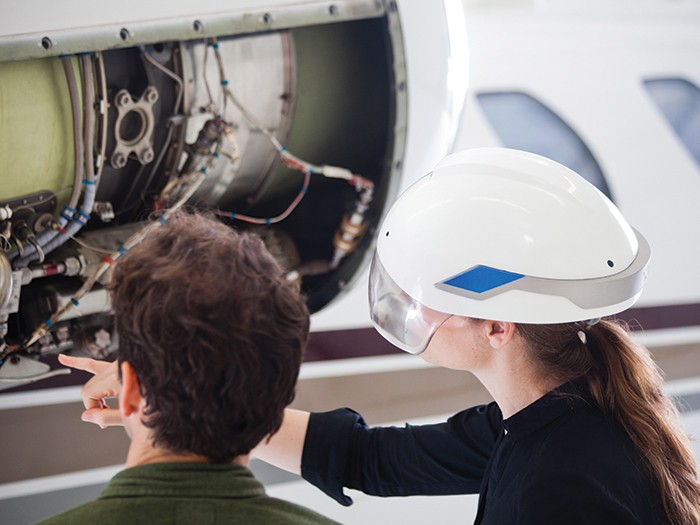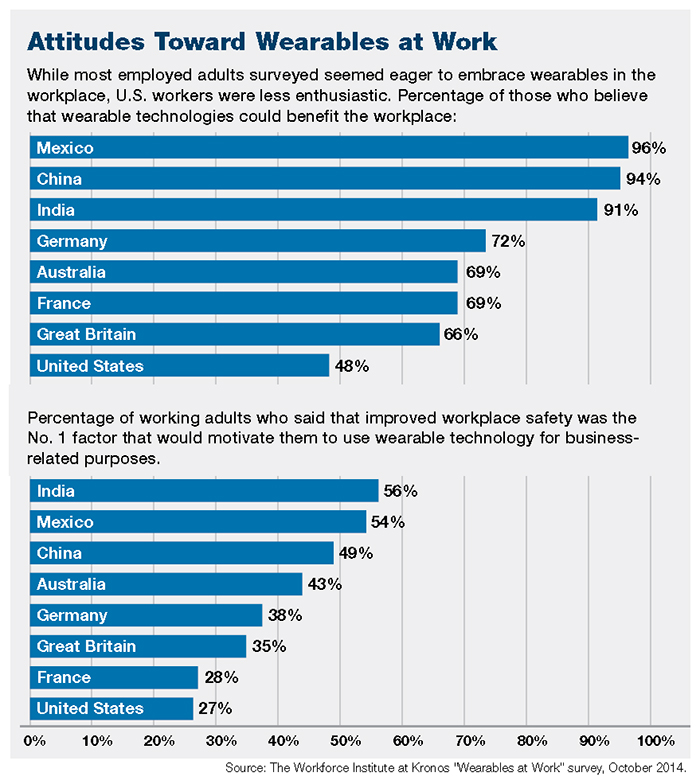Wearable Technology
Putting Wearables to Work

Before long, you’ll be reading about all kinds of quirky wearable technology — like false eyelashes that can change your TV channels or even launch drones. Most of it, though, is far less fanciful.
The wearable space now extends to jewelry, watches, clothing, shoes, glasses, hats, helmets — you name it. These accessories carry embedded biosensors, actuators and gyroscopes to follow movement, heart rate, stress level, fatigue, and countless other metrics … all of it connected wirelessly to mobile devices and computers. Shipments of smart wearables are expected to grow from 9.7 million in 2013 to 135 million in 2018, according to analysts at CCS Insight.
But this amazing itty bitty tech is no longer just fodder for making tech bloggers swoon — it’s beginning to drive safer workplaces and improve workplace injury outcomes, even making a dramatic difference in the lives of workers with catastrophic injuries.
On the safety side, high-hazard industries such as energy and construction are already exploring the possibilities, with applications for Google Glass, smart safety helmets and any number of sensor-enabled devices that can identify hazardous conditions such as toxic chemical fumes or equipment under excessive pressure.
Clothes with embedded technology such as the shirts Ralph Lauren debuted at the U.S. Open last year could help supervisors monitor their crews’ stress levels, respiration, heartbeat, and energy output. A company called MC10 in Cambridge, Mass., is testing a small translucent patch that can detect body temperature and measure hydration levels — both ideal tools for reducing the risk of injuries for outdoor crews or those that work in extreme-temperature environments.
“If a doctor says, ‘I want you to get up and move every hour,’ there are certainly wearables that can report back to a physician or a case manager about activity levels.” — Kimberly George, senior vice president, corporate development, M&A and healthcare, Sedgwick
Conscious Clothing, the winner of a $100,000 Department of Health and Human Services and Environmental Protection Agency prize, developed a shirt that will monitor the wearer’s breathing and the surrounding air quality.
Smart glasses add the practical dimension of visual display and video capture. Imagine a complex construction task in a hard to reach location. An older, more experienced worker might be at physical risk trying to reach it, while a younger worker could get there, but not have the experience to perform the task safely.
With a pair of smart glasses and an earpiece, however, the young worker can allow the experienced worker to see the task through his eyes, and the veteran can give guidance on how to do the task safely. Added bonus: The entire task can be recorded and used for future training purposes.
The potential wearable applications for injury reduction are practically limitless. Sensor equipped smart shoes can help measure flooring conditions, alerting both workers and supervisors to potential hazards. Even for office workers, there’s a pin that helps reduce neck and back injuries by alerting the wearer of poor posture.
Where things really get interesting is where wearable sensors begin to interact with environmental sensors. Try to imagine lighting on the assembly line that automatically adjusts for the specific needs of the person working below it, or wristbands that send human proximity alerts messages to machines, automatically shutting down or overriding an accidental start-up if there’s a person within 12 inches of a moving part.
The potential for eliminating entire categories of injuries is actually within reach.
Driving Compliance
Wearables have plenty of roles to play in injury management and return-to-work as well. The simplest applications come in the form of alerts sent to a smart watch, reminding an injured worker about a doctor’s appointment, or that it’s time to do the stretches prescribed by the physical therapist.
The video chat capability of a smart watch could be an easy means for supervisors to check in with injured workers recovering at home, keeping the connection to the workplace strong and reducing feelings of isolation.
The now ubiquitous fitness trackers are increasingly popular as wellness tools, but have a significant place in comp as well, said experts including Sedgwick’s Kimberly George, senior vice president, corporate development, M&A and healthcare.
In a case where the outcome for a worker’s knee surgery or back surgery would be improved by the loss of 40 pounds, for example, a fitness tracker band affords an opportunity to help motivate the worker, and also track whether he or she is complying with the treatment plan’s activity goals. The bands could be equally useful post-surgically — not to be punitive, but to give case managers the opportunity to nip problems in the bud.
“If a doctor says, ‘I want you to get up and move every hour,’ there are certainly wearables that can report back to a physician or a case manager about activity levels,” said George.
“Now could someone manipulate it? Yes. But the point is that you want to be able to use it to empower that patient, rather than as a ‘gotcha.’ ”
Other types of sensor driven trackers could be useful in ensuring that workers in light duty assignments don’t jeopardize their recovery. Sensors in shoe inserts, for instance, could vibrate or send a smart watch alert if a worker exceeds a 10 pound lifting restriction. Motion-sensing trackers could let a recovering worker know when it’s time to switch to a less repetitive task.
Different varieties of smart T-shirts and vests are being tested, to help support the muscles of a worker with a back injury or recovering from surgery, and also to send gentle vibrations whenever the wearers’ posture may be compromising the safety of their back or neck.
George said she sees the full potential of wearables coming when people learn how to use them to get ahead of injuries before they become cost drivers. Some examples might be shoes that detect gait and wear patterns and send alerts if workers could be at risk for knee injuries, or sensors that detect if the way a worker is moving is putting him or her at greater risk for a fall.
“The problem with comp is that we wait until something’s happened,” said George.
“When I think about the wearable space … the best [possibility] is that we can engage them earlier — even before a workers’ comp injury has occurred.”
Help for the Toughest Comp Cases
The impact of wearable technology is most dramatic as it can be applied in cases of catastrophic workplace injuries, including those suffering from brain injuries or who are paraplegic or quadriplegic.
“With wearable tech … I’m able to give them the control to their world.” — Zack Craft, vice president of rehab solutions and complex care, One Call Care Management
Connected technology — including smart watches and Google Glass, combined with a bevvy of mobile apps and environmental sensors — is opening doors for these workers that were closed only a few short years ago.
“When we look at catastrophic cases, especially our paras and quads, they do lose control — they have to ask somebody to do for them all the time,” explained Zack Craft, vice president of rehab solutions and complex care at One Call Care Management.
“With wearable tech … I’m able to give them the control to their world.”
A person with the ability to at least move a finger, said Craft, can use a smart watch to operate lights and a thermostat or even drive a powered chair more efficiently.
Wearables and mobile apps are even helping those unable to speak, by way of an interface where users touch pictures to communicate.
“An old system that would give someone the ability to speak used to run around $10,000,” said Craft.
“Now I’m able to give that person a smartwatch and download some simple applications, and for under $1,000 I can give someone who lost his voice because of heat stroke the ability to communicate. We can even put it in his native language.”
Not only are the new wearable technologies far cheaper than systems available in the past for catastrophic injuries, they’re also more universally accessible, he added.
“A lot of our injuries are labor-based injuries, and the level of education may be limited. So when you’re looking at high-tech … they just didn’t have the [skills] to operate those systems.”
Weighing Risks and Rewards
There is an enormous amount of potential in the wearables space for safety and comp — potential for reducing injuries and improving patient outcomes. But with that potential comes a degree of risk and a lot of questions that can’t be answered until the technology is more widely utilized. First and foremost, say experts, is whether or not companies can get buy-in from employees.
“It all comes back with the human being — are they willing to accept those kinds of things from their company … it’s kind of the Big Brother concern,” said Paul Braun, managing director with Aon Global Risk Consulting.
“If you’re wearing something that’s going to tell your employer what you do every minute of the day, are you going to accept that and are you going to operate that way? Because that’s really where the challenge on the workers’ comp side is.”
There are also concerns that collecting certain types of data will ultimately backfire on employers. What if, for instance, sensor-enabled wearables recorded a significant amount of unsafe movement or actions by employees? There’s a worry that some employers could suddenly find themselves the target of unsafe workplace accusations.
Braun used the example of a client that was considering the use of athletic helmets that could record and track impact to the head during the playing career of each student.
“The concern that the group had was, ‘OK, what if you’ve got all of this information and you didn’t do anything about it? Or what if a lawyer got a hold of it … what happens if they subpoena the database and our team didn’t take any corrective action?’ ”
Another question raised was what if a crafty lawyer hacked into the database or hired someone to do so.
“Now he’s got a pure list of potential clients,” said Braun.
For most employers though, the more immediate question will be how to take all of this new data and turn it into meaningful information that will inform action. The data, said Sedgwick’s George, is only as good as its ability to change behavior or to improve someone’s health.
“Don’t just think you can throw all these trackers out there and it will improve health,” said George.
“There has to be a meaningful way in which the [provider] and the patient benefit, or it’s just another device.”
Interoperability is key, said George, particularly given the changing health care landscape, and the fact that the management of wellness may not need to be at the physician level.
“We have to think about having more nurse practitioners, athletic trainers, physician assistants and nutritionists, with some of these wearables monitoring the maintenance of chronic disease or healing of wounds after surgery. … Interoperability and how the device is actually meaningful both to the patient and to the care team is important.”
Clearly, the industry is going to have to address some of these issues sooner rather than later, or risk falling behind.
Said One Call’s Craft, “The technology is moving so fast that it seems like weekly, if not daily, something new is coming out — something that gives us more capability than we even had eight hours ago.
How do you keep up with that? And who’s keeping up with it? The industry is getting bombarded by it.”
“It’s not that far out,” agreed George. “When you begin to factor in the genomics, the sensors, the nanotechnology — it’s a little overwhelming but it’s pretty amazing.”












